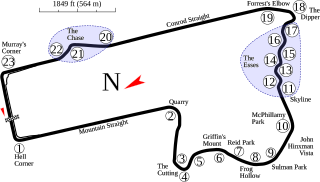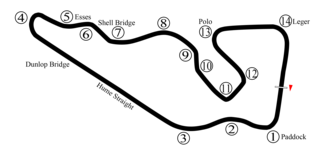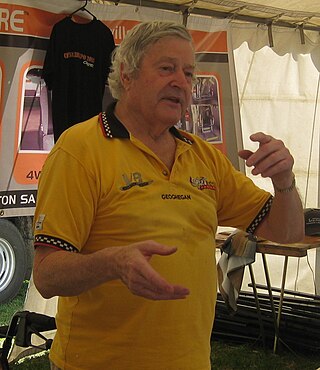
The Bathurst 1000 is a 1,000-kilometre (621.4 mi) touring car race held annually on the Mount Panorama Circuit in Bathurst, New South Wales, Australia. It is currently run as part of the Supercars Championship, the most recent incarnation of the Australian Touring Car Championship. In 1987 it was a round of the World Touring Car Championship. The Bathurst 1000 is colloquially known as The Great Race among motorsport fans and media. The race originated with the 1960 Armstrong 500 with a 500 mile race distance at the Phillip Island Grand Prix Circuit; it was relocated to Bathurst in 1963 also with the 500 mile distance and has continued there every year since, extending to a 1,000 kilometer race in 1973. The race was traditionally run on the New South Wales Labour-Day long weekend in early October. Since 2001, the race has been run on the weekend following the long weekend, generally the second weekend of October.
The Australian Touring Car Championship (ATCC) is a touring car racing award held in Australia since 1960. The series itself is no longer contested, but the title lives on, with the winner of the Repco Supercars Championship awarded the trophy and title of Australian Touring Car Champion.
The 1969 Australian Touring Car Championship was a CAMS-sanctioned Australian motor racing title open to Group C Improved Production Touring Cars and Group E Series Production Touring Cars. The championship, which began at Calder Raceway on 23 March and ended at Symmons Plains Raceway on 16 November, was contested over a five heat series. It was the tenth running of the Australian Touring Car Championship and the first to be contested over a series of heats rather than as a single race.
The 1970 Australian Touring Car Championship was a CAMS-sanctioned motor racing title for drivers of Group C Improved Production Touring Cars and Group E Series Production Touring Cars. The title, which was the 11th Australian Touring Car Championship, began at Calder Park Raceway on 22 March 1970 and ended at Symmons Plains Raceway on 15 November after seven heats.
The 1971 Australian Touring Car Championship was a CAMS-sanctioned motor racing title for drivers of Group C Improved Production Touring Cars and Group E Series Production Touring Cars. The title, which was the 12th running of the Australian Touring Car Championship, began at Symmons Plains Raceway on 1 March 1971 and ended at Oran Park Raceway on 8 August after seven heats.
Ian Anthony "Pete" Geoghegan, was an Australian race car driver, known for a quick wit and natural driving skills. Sometimes referred to as "Pete" Geoghegan, he was one of the iconic characters of the 1960s and 1970s Australian motor racing scene. His older brother Leo was also an accomplished driver and the brothers often shared a car in endurance events.
Henry Leslie Firth, OAM was an Australian racing driver and team manager. Firth was a leading race and rally driver during the 1950s and 1960s and continued as an influential team manager with first the Ford works team and then the famed Holden Dealer Team (HDT) well into the 1970s. Firth’s nickname was "the fox", implying his use of cunning ploys as a team manager.
The Ford works team was the unofficial name for an Australian motor racing team which was supported by the Ford Motor Company of Australia. The team was formed in 1962 and was disbanded when Ford Australia withdrew from motor racing at the end of 1973. Drivers for the works team included Allan Moffat, Fred Gibson, Harry Firth, Bob Jane, Barry Seton, Bruce McPhee, John French, Ian Geoghegan and his brother Leo Geoghegan. Ford Australia also supported a factory rally team in Australia from 1977 to 1980.

The 1961 Australian Touring Car Championship was a CAMS sanctioned Australian motor racing title for drivers of Appendix J Touring Cars. The championship, which was contested over a single, 50 mile (82 km) race at the Lowood Airfield Circuit in Queensland on 3 September 1961, was the second Australian Touring Car Championship. The race, which was promoted by the Queensland Racing Drivers' Club, was won by Bill Pitt, driving a Jaguar Mark 1 3.4.
Norman Edward Beechey is a retired Australian race car driver, who was given the nickname "Stormin Norman" by his fans. To some, he was the closest thing Holden had to a star racing driver, before Peter Brock. Beechey competed in the Australian Touring Car Championship from 1963 to 1972 winning the title in 1965 driving a Ford Mustang and in 1970 at the wheel of a Holden Monaro. Along the way, he achieved seven round wins, and one pole position. His championship win in 1970 was the first victory by a Holden driver in the Australian Touring Car Championship.

The 1964 Armstrong 500 was a production car race held on 4 October 1964 at the Mount Panorama Circuit just outside Bathurst in New South Wales, Australia. The 500 mile race was open to Australian built production sedans of which 100 examples had been registered. It was the fifth Armstrong 500 and the second to be held at Bathurst although it is commonly referred to as the fifth "Bathurst 500".

The 1963 Armstrong 500 was the fourth running of the Armstrong 500 touring car race. It was held on 6 October 1963. After the 1962 race, the Phillip Island Grand Prix Circuit was too damaged to continue to stage the race, forcing it to move to a new location, the Mount Panorama Circuit just outside Bathurst with a new organising club, the Australian Racing Drivers Club. The race was open to standard production sedans with four classes based on the purchase price of the vehicle.
The 1965 Australian Touring Car Championship was a CAMS sanctioned motor racing title open to Group C Improved Production Touring Cars. It was contested over a single 40-lap race staged at Sandown Raceway in Melbourne, Victoria, Australia on 11 April 1965. It was the sixth Australian Touring Car Championship title to be awarded and the first to be contested by cars complying with Group C regulations.

The 1966 Australian Touring Car Championship was a CAMS sanctioned Australian motor racing title open to Group C Improved Production Touring Cars. It was contested over a single 20-lap race staged at the Mount Panorama Circuit near Bathurst in New South Wales, Australia on Easter Monday, 11 April 1966, and was the seventh running of the Australian Touring Car Championship. The race was sponsored by the Neptune Oil Company, Sydney.

The 1962 Australian Touring Car Championship was a CAMS sanctioned Australian motor racing title for Appendix J Touring Cars. It was contested as a single race, staged at the Longford Circuit, in Tasmania, Australia, on 3 March 1962. The title, which was the third Australian Touring Car Championship, was won by Bob Jane, driving a Jaguar Mark 2 3.8.
The 1963 Australian Touring Car Championship was a CAMS sanctioned motor racing title for drivers of Appendix J Touring Cars. It was contested over a single 25 lap, 50 mile (80 km) race at the Mallala Race Circuit in South Australia on 15 April 1963 and was the fourth running of the Australian Touring Car Championship. The race was won by Bob Jane, driving a Jaguar Mark 2 4.1.

The 1967 Australian Touring Car Championship was a CAMS sanctioned national motor racing title open to Group C Improved Production Touring Cars. It was contested over a single race, staged at the Lakeside Circuit in Queensland, Australia on 30 July 1967. The title, which was the eighth Australian Touring Car Championship, was won by Ian Geoghegan, driving a Ford Mustang.

The 1968 Australian Touring Car Championship was a CAMS sanctioned Australian motor racing title open to Group C Improved Production Touring Cars. It was contested over a single race staged at the Warwick Farm circuit in New South Wales, Australia on 8 September 1968. The title, which was the ninth Australian Touring Car Championship, was won by Ian Geoghegan driving a Ford Mustang. It was the final Australian Touring Car Championship held as a single race, with the title being contested over a series of races from 1969 onwards.

Leo Francis Geoghegan was an Australian racing driver. He was the elder of two sons of former New South Wales car dealer Tom Geoghegan, both of whom become dominant names in Australian motor racing in the 1960s. While his younger brother Ian "Pete" Geoghegan had much of his success in touring car racing, winning five Australian Touring Car Championships, Leo spent most of his racing career in open wheel racing cars.
James Walter McKeown was an Australian racing driver who competed in the Australian Touring Car Championship from 1964 to 1972, with a best finish of 2nd in the 1970 ATCC. McKeown was part of the successful Neptune Racing Team alongside Norm Beechey and Peter Manton. The team later became known as the Shell Racing Team and consisted of McKeown in a Porsche 911S, Beechey in a Holden Monaro GTS350 and Manton in a Morris Cooper S.







